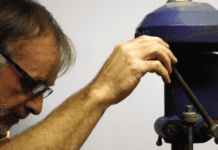If you’re a fan of Patrick O’Brian’s books, you’ll remember some of the scenes throughout the Aubrey-Maturin series when Jack Aubrey is ashore and his house and grounds are being tended by some of his ship’s crew as they all wait to get afloat again. I love those scenes, because they remind me of why the water is better than the land. Aubrey’s tars, used to rigorous schedules and maintenance chores at sea, are a bit like fish out of water as they attempt to straighten and square away every stone and doorjamb, cover everything in paint and whitewash, and generally make the somewhat dishevelled estate conform to the geometry of a warship in the Royal Navy.
These attempts are funny and endearing, at least to me. I like the ingrained habits and disciplines of my fellow sailors, even if they can seem a bit compulsive, if not hidebound, to those who don’t have to worry about whether they’ll waft down to Davy Jones’ locker, drowned, by the end of the day, because of something carelessly left undone or askew.
My friend Kim, whose family sailed for many years with Rod Stephens, says that the highest praise Rod could bestow on a piece of gear or an onboard system was, “I don’t see how that could be improved upon.” It was a rare commendation, and an indication of the sailor’s mentality-always looking for ways to make something smoother, tighter, hardier, safer, smarter. Kim has a habit, to this day, of modifying pretty much everything he buys-because most everything can be improved upon, at least for his purposes, if only by the addition of a lanyard hole, an extra dart of fabric, or a reshaped handle.
Seagoing habits of organization serve very well ashore, as do habits of observation, calculation, self-reliance, and curiosity.
The habit of learning new things is also pronounced, even if unintentional. Intensive learning can’t be helped if you spend any appreciable time near other sailors and the sea. Eventually, we learn a bit about oceanography, meteorology, and marine biology. We learn something of electricity and mechanics. If we travel far enough, we learn about other nations and peoples. We learn first-hand about the foulness of pollution and hyper-production in a throwaway culture, and the importance of renewable energy and conservation.
The habit of paying attention to these things is naturally carried from ship to shore, where it makes life on terra firma a bit more interesting.
This sport, this calling, is a microcosm for many of the most fascinating things in life. It encompasses natural wonders, both constant and occasional, and adventure, both quiet and hair-raising. It gives us an honest and encouraging view of our place in the universe. (When you’re a speck, you get perspective.) It then connects us with the history of our predecessors as they harnessed the Cartesian view of the world, and the Copernican and Galilean views, to practical methods for finding their way around the planet.
In the close confines of a boat we learn more in a day about the people we’re with than we would in a month on land-or maybe ever. Friendships forged afloat are the strongest.
But it’s those little routines and disciplines, including the urge to improve upon, that make all the difference, day to day, even if they sometimes seem out of place ashore.
I suspect that the sailor’s fondness for simple, geometric arrangements, and the predictability of routine, and the compulsion to square away everything within reach, is in fact an acknowledgment that chaos is lurking just around the corner in the form of a line squall, or maybe a visit from a mother-in-law or tax auditor, and he will at least take comfort in knowing where to lay his hands on things, and where to step, when the darkness descends and rough stuff starts.
-Doug Logan



































